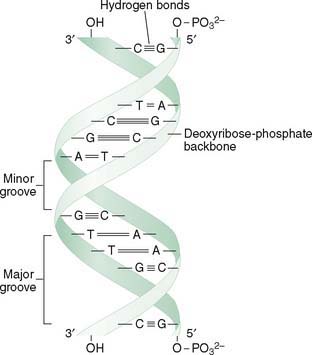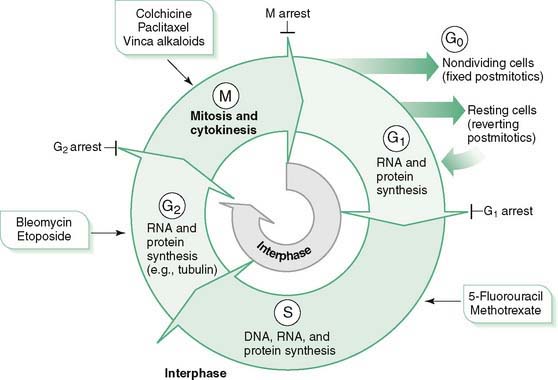Chapter 11 Organization, Synthesis, and Repair of DNA
I. DNA Organization
A. Overview
1. Two characteristics of DNA that affect its organization in the nucleus: extreme length and predominance of noncoding sequences
2. Supercoiling allows compaction of DNA while allowing selective expression of genetic information.
B. Nucleosomes
1. Chromatin is a complex of double-strand DNA (Fig. 11-1) associated with histone proteins and other proteins that folds and packs to form the chromosomes.
a. Histones are basic proteins (positively charged) that associate tightly with acidic DNA (negatively charged).
b. The nucleosome, the basic structural unit of chromatin, is made up of a core containing a total of eight histones (two molecules each of histones H2A, H2B, H3, and H4), around which DNA is wrapped twice (Fig. 11-2).
c. Linker DNA, which is associated with a fifth type of histone (H1), connects adjacent nucleosomes and produces the “beads on a string” form of chromatin.
D. Repetitive DNA and transposons
1. Repetitive DNA is constituted from repeated sequences (from two base pairs to several thousand) that are arranged in tandem; they constitute about 30% of the genome.
2. An alternate term for repetitive DNA is satellite DNA (i.e., appears as a satellite band in centrifugation).
4. Transposons, also referred to as jumping genes, are DNA sequences that can jump to different areas of the genome within the same cell.
5. Retrotransposons are a class of jumping genes that use reverse transcription by a cellular reverse transcriptase (see Section II, E later) encoded in the genome of normal, uninfected cells.
a. Insertion of a jumping gene into an active gene causes an insertion mutation, which prevents expression of normal protein.
b. Jumping gene insertion can cause genetic diseases such as hemophilia and Duchenne muscular dystrophy.
II. DNA Synthesis




B. The cell cycle (Fig. 11-3)
1. The cell cycle is an ordered sequence of events during which proliferating cells replicate their chromosomes and separate into daughter cells.
2. The cell cycle consists of interphase, followed by mitosis (nuclear replication) and cytokinesis (cell division).
a. Interphase consists of a G1 (first gap or growth) phase, an S (synthesis) phase, and a G2 phase.
G1 to S phase is the most important phase to control.
G1 and G2 phases: gap (G) periods of RNA and protein synthesis
(1) The G1 and G2 phases are periods of RNA and protein synthesis for general growth of organelles and mitotic structures; no DNA synthesis occurs.
(2) Resting cells in the G0 phase reenter the cell cycle early in the G1 phase, the most variable phase of the cell cycle.
3. Cell cycle control proteins regulate progression through the cell cycle.
a. Cyclin-dependent protein kinases (CDKs) phosphorylate various target proteins, thereby modulating their activity at different stages of the cell cycle.
4. Checkpoints are positions in the cell cycle where progress can be arrested to prevent formation of abnormal daughter cells (see M, G1, and G2 arrests) (see Fig. 11-3).
a. When DNA is damaged, the G1 checkpoint prevents entry into the S phase, and the G2 checkpoint prevents entry into mitosis.
(1) Expression of TP53, a tumor-suppressor gene (on chromosome 17) that is required for operation of the G1 and G2 checkpoints, codes for a protein product that inhibits activated CDKs.
(2) Arrest of the cell cycle allows time for DNA repair and reduces the chances for perpetuation of mutations.
Stay updated, free articles. Join our Telegram channel

Full access? Get Clinical Tree





